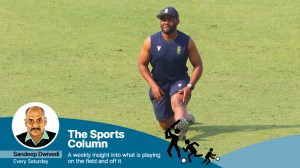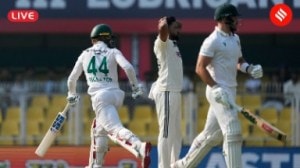Hungarian boost for fabulous four
MUMBAI, August 3: Under normal circumstances, Deepali Deshpande, 30, Anjali Vedpathak, 29, Anuja Tere, 28, and Suma Dixit, 25, would neve...

MUMBAI, August 3: Under normal circumstances, Deepali Deshpande, 30, Anjali Vedpathak, 29, Anuja Tere, 28, and Suma Dixit, 25, would never have met. While Deepali lives in the north-eastern suburb Andheri, Anjali comes from the central suburb of Dadar, while Anuja and Suma live in the northern and eastern edges of Mulund and Panvel respectively.
It was the rifle that brought them together. The four women, owners of brains as sharp as their shooting, today represent India’s chief hopes in international shooting. And the Shooting Federation of India’s (SFI) decision to hire the services of Hungarian coach Lazslo Suzchak to oversee their progress is quietly bearing fruit.
Almost too quietly, you may think. A National record was laid low last month, without anyone taking notice.
Deepali Deshpande (30), an architect from Mumbai who is currently in the National camp under Suzchak, rewrote the 10m air rifle National record (women) at the World Cup in Atlanta early in July. Her 393 (out of 400) bettered the 390Anuja had set at the Commonwealth Games last year.
Anjali (CISF) and Suma (Western Railway) also came back guns blazing. Anjali’s 574 in the rifle three-position at Atlanta was her best ever, a ten-point improvement on her previous high of 565.
Suma shot an incredible 397 (in 10m air) during the selection trials for Atlanta, an effort which Deepali says inspired her. “I think my self-image improved when she (Suma) scored 397,” Deepali told The Indian Express in Mumbai, where the foursome was enjoying a three-week break from round-the-clock camps in Delhi.
It was difficult to get them together, physically and mentally — they just did not feel liking shooting their mouths off. After much persuasion they consented, two days before leaving for another series of camps at Bangalore. The venue was the Worli Shooting Range, where the four first met, and honed their skills, long before they became compatriots — and friends.
At the last moment, Anuja could not make it. She had to obtain clearancesfor the rifle she had purchased from Germany, which had just arrived. “She desperately wants to carry the rifle with her to Bangalore. Lazslo will not let her replace her practice rifle with it at a later stage,” Suma explained.
It was obvious the women were devoted to the Hungarian. Anjali said, “He has helped us in technical aspects like how to cope up with the wind. Then he found the jackets and trousers we were using not up to the mark, and asked us to order new sets from Korea. The costume itself has improved our performance by 5-6 points.”
The new outfit is much heavier, and Suma admitted “they are difficult to walk in. But it has steadied our performance.”
Suzchak, they say, has also drawn up a schedule for them for the next two years, the period of his contract with Sports Authority of India. Deepali said, “Lazslo has highlighted the major tournaments we will be participating in, and the simulation exercises will help us peak at the right time. That is something we have never been exposedto before.”
Anjali added, “Because of our professional and systematic training, our temperament has become steadier. Earlier we used to get nervous during the competition, now the pressure is normal, and shooting is more automatic, as it should be.”
They have been set a target. Win medals at the Olympics or else … “He has threatened to shoot us down if we don’t,” says Suma with a smile.
One thing that strikes you, when you listen to the three talk, is how philosophical they are, defintiely more than the average sportsperson. Deepali talks about how she is her own opponent’, Anjali mentions how shooters devise self-talk for concentration’, while Suma explains how she is learning to listen to her own body.’
They attribute this Zen in the Art of Shooting’ to Sanjoy Chakraverty, their coach from early days, and assistant coach of the Indian Asian Games squad.
Sanjoy, who was hovering around, explains: “Shooting better is all about a person understanding his own body better. In trying tounderstand where the movement is arising. Any movement of the body, when the gun rests on the shoulder, has to be controlled. It is a type of yoga.”
Sanjoy says it takes 12-14 years for shooters to reach world-class. “With competition very high, the girls have to achieve cent per cent perfection. They have to cut themselves off from society.”
Thankfully, these four women are ready to make the sacrifices to reach higher. They bemoan that not many other women are willing to, leaving India with virtually no second string — there are no promising juniors on the horizon. But they are glad they have each other.
Anjali says, “when Suma shot 397, I felt, if she’s shooting this much, I can also do well. It is a boost for us.” Deepali adds, “People from other states tell us, you have so much competition (among you) in Mumbai itself, that is why you are doing well.”



- 01
- 02
- 03
- 04
- 05




























